If you ever have the opportunity to look into a bird’s eyes, you will be treated to a rainbow of hues. Greens, oranges, browns, whites, yellows, and reds range in intensity from white to black.
Birds’ eyes stand out because they lack the whites that humans possess surrounding their irises.
In this post, we’ll explore what kinds of birds possess red eyes and discover more about them.
Although no one flock of birds has a certain eye color, there is a consistent coming-of-age pattern observed in various species.
For certain birds, a variation in eye color can signal the start of maturity.
While we could discuss all of the birds having long beaks, today, we will focus on the birds with red eyes.
| Image | Name |
|---|---|
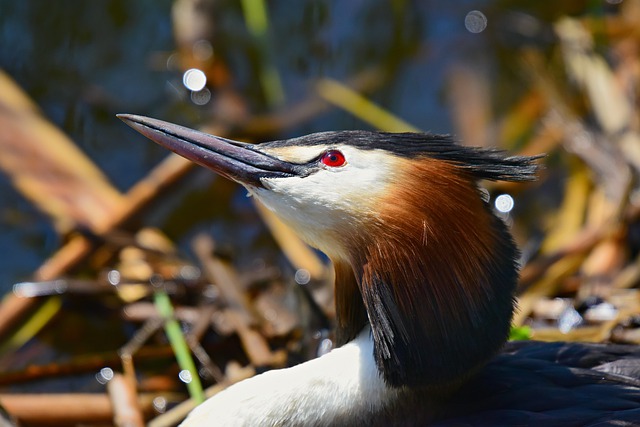 | Great Crested Grebe |
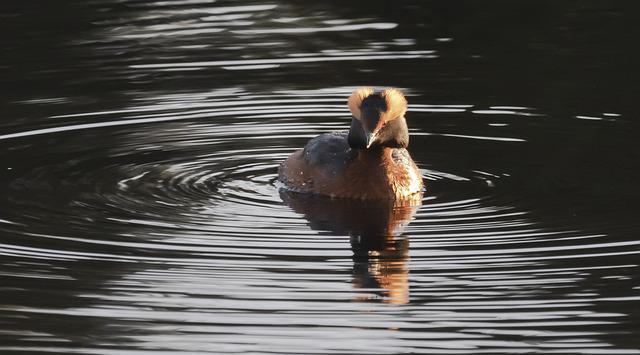 | Horned Grebe |
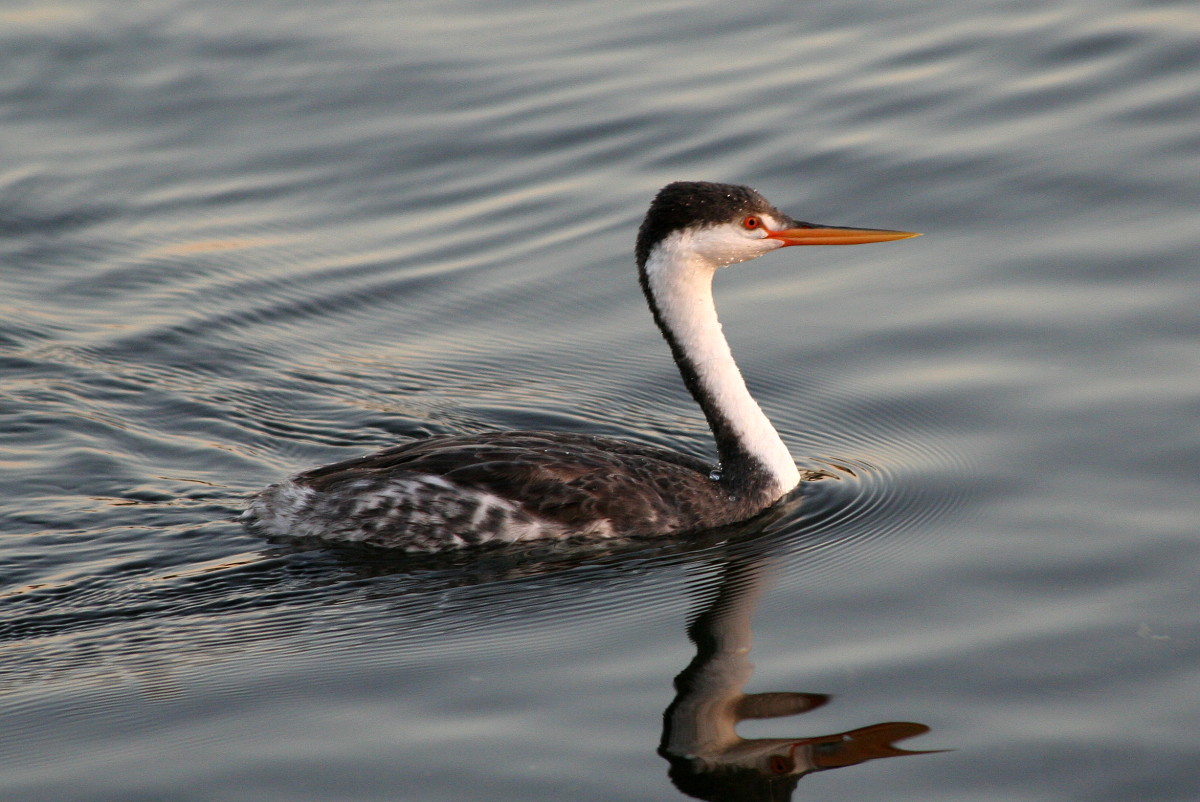 | Clark's Grebe |
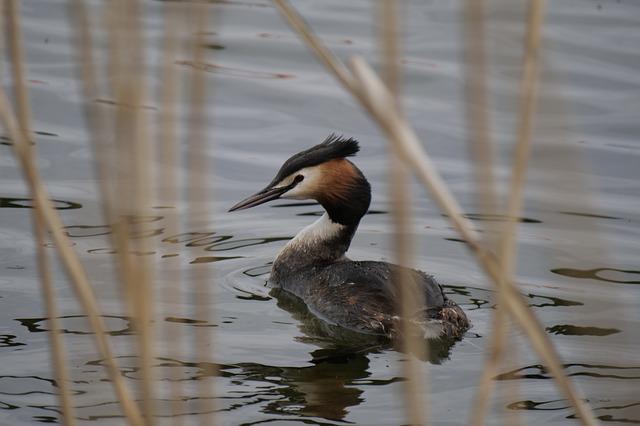 | Western Grebe |
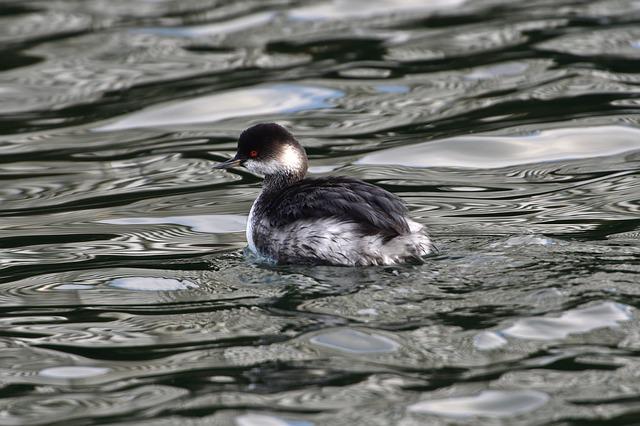 | Black-Necked Grebe |
 | American Coot |
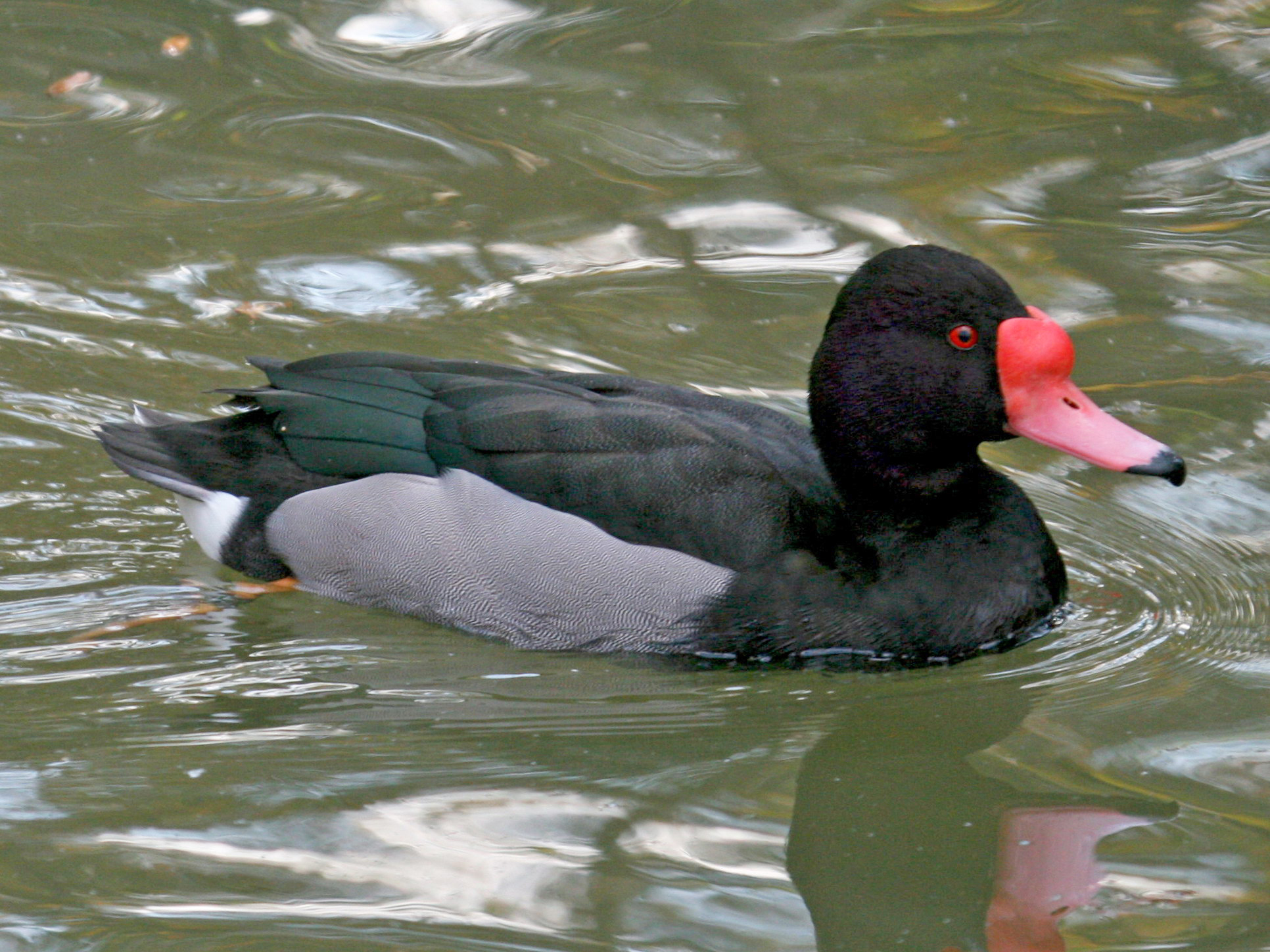 | Rosy-Billed Pochard |
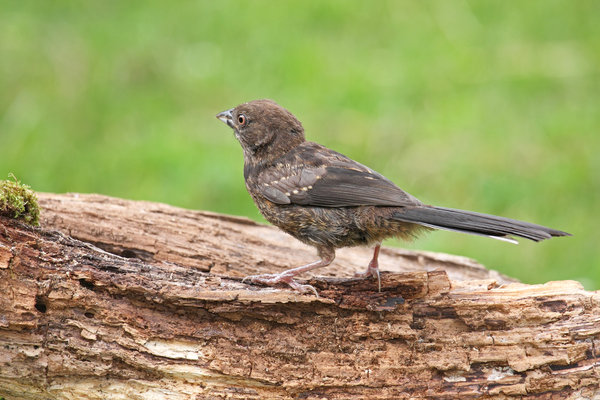 | Spotted Towhee |
 | Wood Duck |
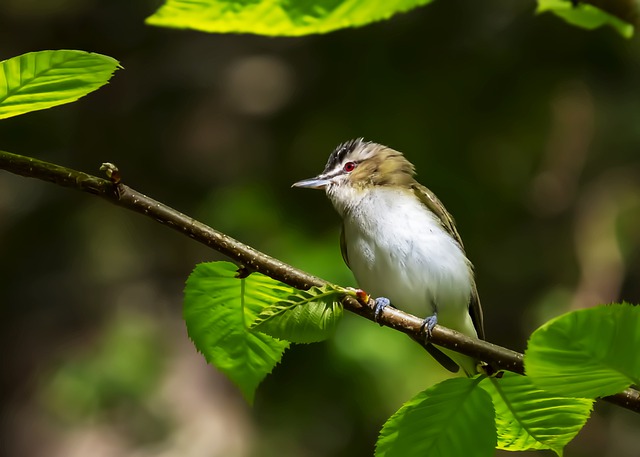 | Red-Eyed Vireo |
 | Cinnamon Teal |
 | White-Winged Dove |
 | Eastern Towhee |
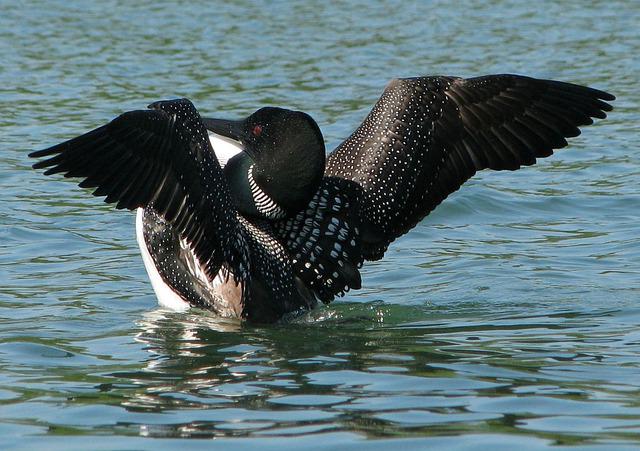 | Common Loon |
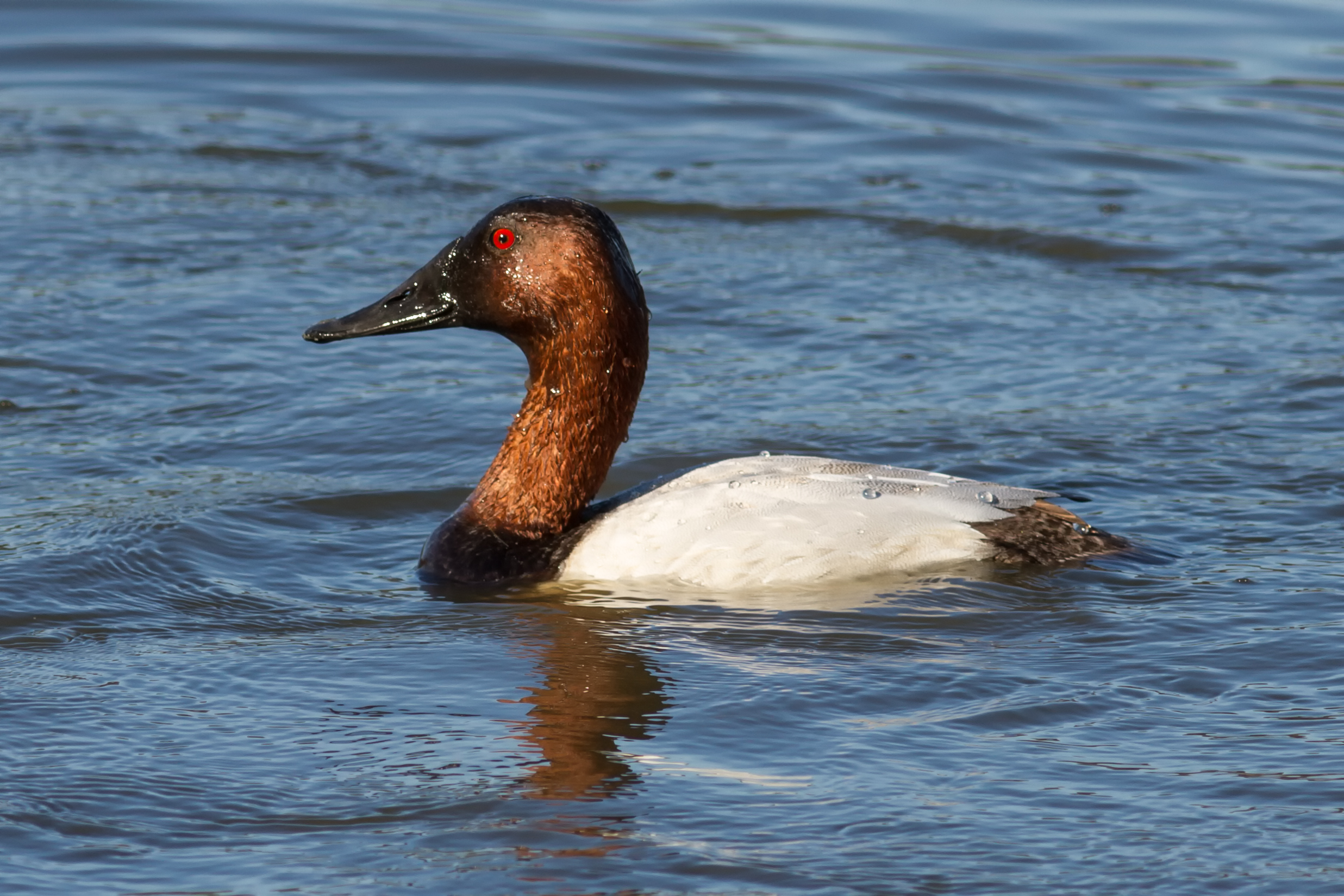 | Canvasback |
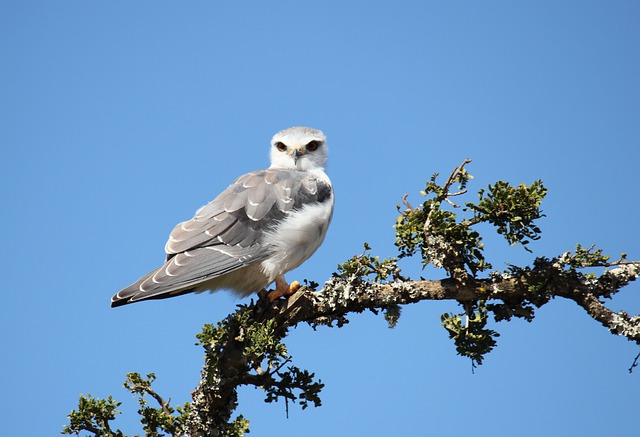 | White-Tailed Kite |
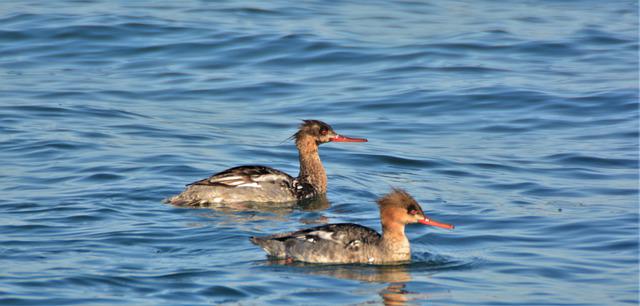 | Red-Breasted Merganser |
 | Asian Koel |
 | Killdeer |
 | Phainopepla |
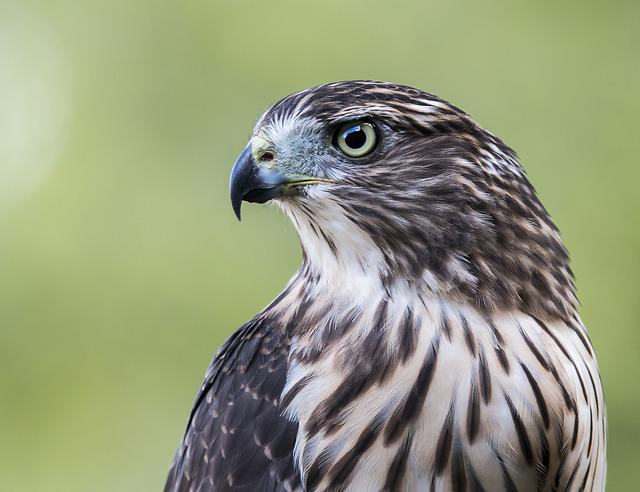 | Cooper's Hawk |
The Birds with Red Eyes are
1. Great Crested Grebe

The black crest atop their heads as well as around their necks distinguishes Great Crested Grebes from other grebes.
Asia, Australia, Russia, Turkmenistan, Mongolia, New Zealand, Europe, and portions of eastern and southern Africa are all home to them.
Their faces and bodies are white, with dark brown feathers and wings and somewhat pink beaks.
They grab their prey undersea and are renowned for being good divers.
2. Horned Grebe

Horned Grebes are frequently referred to as “Slavonian Grebes.” They are divided into two distinct species: the Eurasian, which breeds from western China through Greenland, as well as the North American, which breeds throughout Canada and the United States.
During the mating season, their black and white basic appearance becomes red and black.
These grebes are frequently mistaken for Black-Necked Grebes.
3. Clark’s Grebe

Clark’s Grebes were mistakenly thought to be much like Western Grebes until 1985, despite their many resemblances. Arizona, California, Nevada, and central Mexico are all home to these migrating aquatic birds.
They move to the Pacific Coast in the wintertime. These birds possess pale bodies, long necks, and somewhat tilted yellow beaks. The hue of their plumage is grey in color.
Males have a small spike on their forehead that differentiates them from females.
4. Western Grebe

Western Grebes are indeed referred to as “Swan Grebes” or “dabchick” in folklore. These birds seem comparable to Clark’s Grebes in terms of weight, size, and wingspan.
Western Grebes differ from Clark’s Grebes in that their bills are greenish-yellow rather than the brilliant yellow of Clark’s Grebes.
5. Black-Necked Grebe

In 1831, German naturalist Christian Ludwig Brehm identified the Black-necked Grebes, also known as Eared Grebes. These species have a close resemblance to Horned Grebes, excluding a steeper head.
Their mating plumage is orange in color and reaches over their ears. Their plumage and sides become greyish-white even during the non-breeding period. During the year, their beautiful crimson eyes remain the same.
6. American Coot

The American Coot is a rail-like bird that is distantly related to ducks. Though they may appear to be identical to ducks at first appearance, they vary in key ways.
In contrast to ducks, they possess scaled, toed feet that allow them to navigate on dry ground. They possess short, thick white wings and a black body with a blue tint throughout.
These migrating birds are often known as “pouldeau” or “mud hen” and may be located all throughout North America.
7. Rosy-Billed Pochard
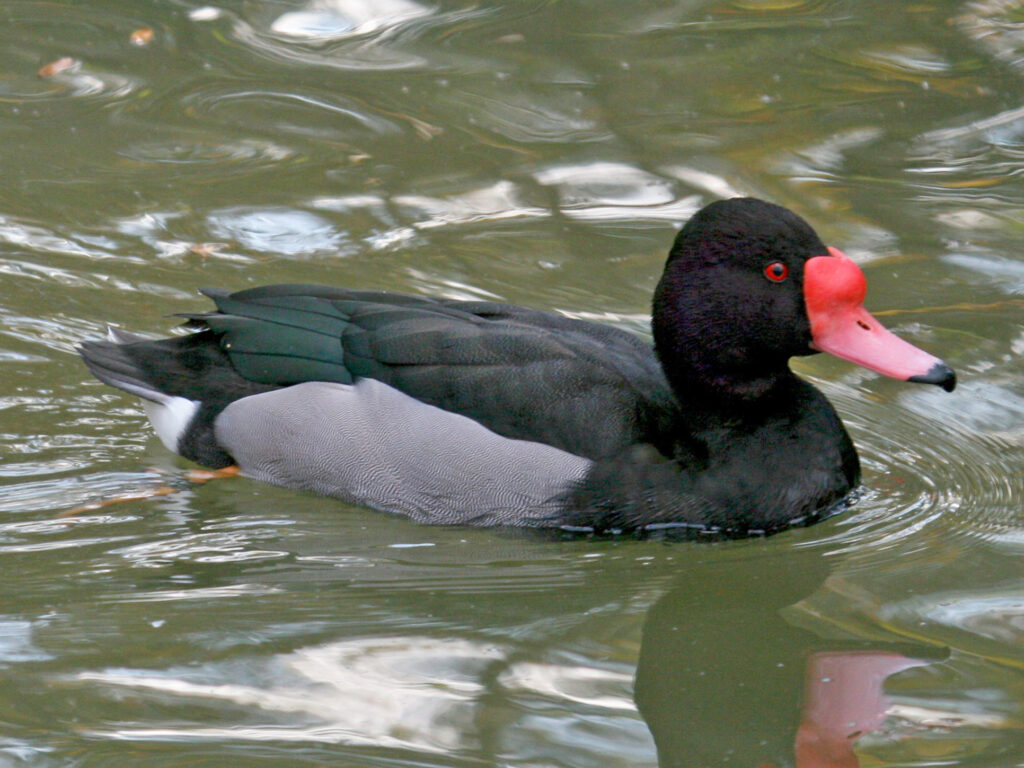
The Rosy-Billed Pochards, sometimes termed “Rosybills,” are diving ducks. South America is home to such birds. These birds may be located in southern Brazil, Argentina, central Chile, Uruguay, and Paraguay.
They move to southern Bolivia throughout the cold season. Their bills are bright crimson with black dots around the edges. Their body is mostly black, with white streaks on their wings.
8. Spotted Towhee

The Spotted Towhee is a passerine bird that belongs to the Global World Sparrow genus. “Oregon towhee” is an old name among them. These birds reproduce all throughout northwestern and North America and live in dry highland forests.
Wetland & riparian woodlands in Arizona, Washington, Oregon, Nevada, Utah, and southern British Columbia are also home to them.
They have a fan-shaped tail which is about the length of a robin. Black on the forehead and throat, brown sides, white underparts, and black wings with white streaks.
9. Wood Duck

The Wood Ducks, sometimes recognized as Carolina Ducks, are by far the most colorful bird in North America. Red eyes and multicolored plumage distinguish these moderate size perching ducks.
The males’ plumage is more vibrant than that of their female counterparts. The females and males both have crested crowns, and only the females get a whitish neck as well as a white eye ring.
10. Red-Eyed Vireo

Red-Eyed Vireos are little songbirds of Americans that resemble Warblers in looks and are not connected to them.
With their white underparts & olive-green upperparts, they have a grey crown with a black tint. Their eyes are tiny and feature bloodred irises. These birds can be found in America’s deciduous woodlands.
11. Cinnamon Teal

Cinnamon Teals are just little dabbling ducks that may be located across South and North America. They love to consume vegetation and reside in wetlands, lakes, ponds, and marshes.
In the event of food scarcity, they can devour insects as well as other tiny creatures. They have cinnamon-colored bodies, crimson eyes, and black bills.
Their upper bodies have a deeper brown color. Females possess grey bills and speckled bodies.
12. White-Winged Dove

White-winged Doves are chubby birds having long, narrow beaks and tiny heads. These subspecies originated in South America and are now distributed throughout the continent.
They may be found in Central America, the southwestern United States, Canada, Mexico, and the Caribbean. They seem grey from afar, but close examination reveals a light-brown body and paler underparts.
13. Eastern Towhee

Eastern Towhees are part of the Existing new World Sparrow genus. Carl Linnaeus was the first one to identify their subspecies in 1785.
They have a blackhead back and tail, rufous sides, and a white abdomen and are known for their stunning look. They can be widespread across eastern North America.
14. Common Loon

The Common Loon, sometimes called the “Great Northern Diver,” is a big representative of the diver genus of birds. They have been distributed across North America and are included in the IUCN’s Least Concern Category.
They are brownish in hue, with a black head and upper body that are patterned with dark grey. During the mating season, nevertheless, they develop a blueish, greenish, or blackish gleam on their upper parts.
15. Canvasback

The Canvasbacks are the biggest of all of the other swimming ducks native to North America. Alexander Wilson, a Scottish-American scientist, identified them in 1814.
They are the same shape as Mallards but also have smaller bodies. Males have a chestnut-red forehead with a grey back, black rump as well as breast, and perhaps a brownish tail.
Females are from the other end and have a dark brown neck and head, with a lighter shade of brown across their body. The beaks of both genders are black.
16. White-Tailed Kite

White-tailed Kites are tiny raptors that may be located in South and North America. Loius Jean Pierre Vieillot, a French ornithologist, was the first one to find these species in 1818.
They are frequently mistaken for gulls based on their coloring. However, when you examine their body structure and flying, they are quite similar to falcons.
They possess grey upperparts and wings with white underparts. Their eyes are crimson and have a dark greyish border surrounding them, as well as a short, curving grey beak.
17. Red-Breasted Merganser

Red-breasted Mersangers are swimming waterfowl that belong to the sawbill genus. Carl Linnaeus, a Swedish botanist, was the first one to uncover these species.
On their forehead, they feature a distinctive spiky crown. The males’ backs and wings have such a green gloss to them. Females, on the other hand, have a drab grey appearance.
During the breeding season, they reside in rivers and lakes, and throughout the winter, they travel to coastal regions, bays, and estuaries.
18. Asian Koel

The Asian Koel belongs to the cuckoo genus and may be discovered in India, China, and Southeast Asia. These species are related to Pacific Koels and Black-billed Koels, and they are both brood parasites.
Their frugivorous habit, on the other hand, distinguishes them from the remainder of such cuckoo species. Their beaks are curled at the sides, and they have crimson eyes as well as a lengthy tail.
Females appear brown having rufous streaks everywhere around their bodies and wings, while males are completely jet black.
19. Killdeer

Pay attention! The Killdeer’s eyes are truly brown. The eye-ring, or the naked skin surrounding their eye, is red. Several species, including shorebirds and gulls, have brilliantly colored eye rings during mating season.
Killdeers are a sort of highland shorebird that may be found on beaches and in farmland all over the globe.
They build their nests on the surface, including grassy parking garage borders or even in the middle of a gravel road!
Parents use a technique known as a distraction show to safeguard their children. They cry and drag their wings as if they’ve been shattered, sprinting just ahead of enemies until they’ve gotten far away from the nest. Then they suddenly revive and fly away!
20. Phainopepla

This silky flycatcher is indeed a rare Southwest desert and scrub species.
They may be discovered in the mesquite desert and arid coastal oak forests of southern California, wherein they feed on mistletoe berries & insects.
They have dark red eyeballs. During flying, the males exhibit large white wing patches just on the margins of the primaries.
I suppose it was the crest that makes this one of my favorite birds. They are frequent desert birds who are curious.
21. Cooper’s Hawk

In North America, there really are 3 Accipiters, all of which have red eyes as individuals. During the first year, baby birds’ eyes are paler, a yellowish-orange color.
The Cooper’s Hawk breeds over most of the United States and is much more commonly observed than the Sharp-shinned Hawk as well as the bigger Northern Goshawk.
All three species could fly and traverse at high speed through the thickest nearby trees and tangling due to their short wide wings plus long tails.
Small birds make up the majority of their food. They’ve been expected to spend the cold weather around bird fountains, much to the chagrin of those struggling to feed their small birds and finches.
Conclusion
So now that you understand all of it, there is to learn about some of the other amazing red-eyed birds, such as where they live, what they feed on, and how they behave, why not share your information among your colleagues so they can learn something new every day as well?
Thank you for your interest in reading this article.
FAQ
Why are pigeons’ eyes red?
Pigeons’ eyes are usually red or orange in hue. This is mostly due to genetics, which explains why the color of parent pigeons is handed on to their offspring.
The color derives from the composition of the vascular system that surrounds the iris of the pigeon’s eye, which really is generally yellow or white in hue.
What causes red eyes in parakeets?
The removal of melanin or pigment from either the budgie’s eyes causes red or crimson eyes. Budgies having red or crimson eyes are often just as nutritious as budgies having black eyes, as much as they’re maintained by a reputable breeder.
Are lovebirds’ eyes red?
The ino gene limits the formation or growth of melanin among lovebirds, whereas the fallow genes diminish melanin to variable degrees. Inos and fallows have a variety of exquisite red eyes due to a lack of or greatly decreased melanin in practically every area of the body.
Are cockatiels’ eyes red?
Their eyeballs are bloodshot. Barring may be seen on the underside of the female’s tail. Because they lack the BLUE genes, cockatiels do not even have a genuine “albino” mutant. Because they are entirely white and have red eyes, they are popularly referred to as “albinos.”
Last Updated on March 22, 2023 by Lily Aldrin
